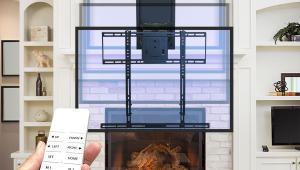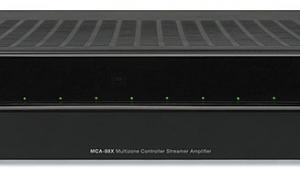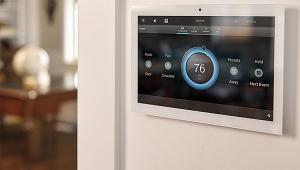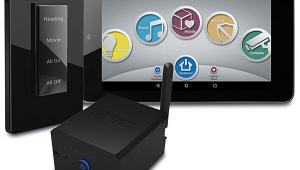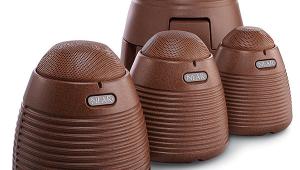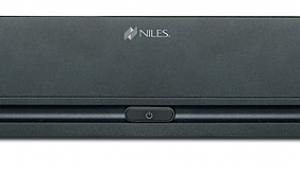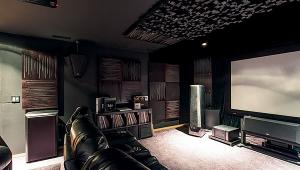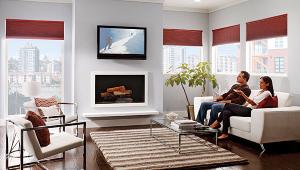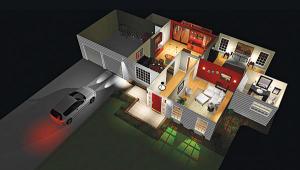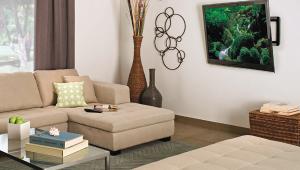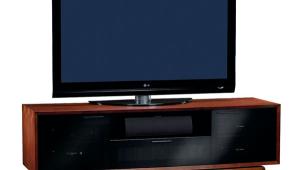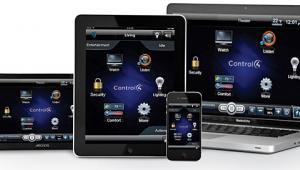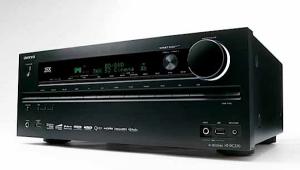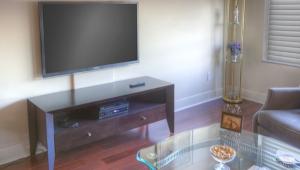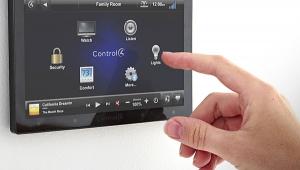Lutron Sivoia Motorized Shade System Page 2
Live Long and Power
There are a number of fascinating things about the Sivoia Wireless QS and Serena cellular shades. Foremost among them is the fact that the shades are both remotely controlled and powered by internal batteries, a combination that qualifies the new Lutron shades as truly wireless. No wall-wart power supplies to plug in. No control wires to connect and hide. Just the shades. As a result, installation is extremely straightforward. The mounting brackets attach to the wall or window’s frame/trim using two screws each, and most shades require only two brackets (the larger sizes come with three or four). Even with my relative incompetence in manipulating hand tools, I was able to measure, mark, drill, screw, and finally snap the shade into its brackets in an average of 15 to 20 minutes per shade. (Although on at least one shade, I had to remount each bracket half an inch more toward the center so the edges of the internal battery compartments wouldn’t interfere with the clips that hold the front of the shade housing to the brackets.) In other words, Serena shades are a do-it-yourselfer’s dream come true, or at least the labor charges ought to be minimal if you have a shade store install them for you. Integrating and programming the Sivoia Wireless QS shades into a control system, however, is definitely not a weekend DIY project; but even including the costs of a custom integrator’s highly worthwhile design, programming, and installation labor, a houseful of Sivoia Wireless QS shades will still be a heck of a lot cheaper than the typical costs of other automated window treatments. And you’ll gain the ability to schedule the shades to move to preset heights at different times during the day, use occupancy/vacancy sensors to trigger shades to open and close, remotely control the shades with iOS or Android apps, and a ton more fun—but, ultimately, very useful—functions, not to mention adding control of light dimmers and switches.

Lutron recommends using standard alkaline D batteries (either four or six, depending on the shade size). Some shade sizes require eight AA batteries, which can be either alkaline or, preferably, lithium. You can use rechargeable batteries, but Lutron says that, because of rechargeable batteries’ high self-discharge current, they could be drained after only a few months. With those off-the-shelf, old-school-technology alkaline batteries, however, Lutron makes the amazing claim of a battery life of three years. That’s based on the assumption of a 3-by-5-foot shade moving up and down twice a day, 365 days a year; and it’s two to three times longer than the estimated battery life of other shades on the market. (One shade I came across listed a battery life of only six months.) According to Lutron, the three elements of the company’s cleverly named Triathlon technology are the reason for such longevity: the use of standard alkaline batteries with their very long shelf life of up to seven years, an efficient hybrid design that can store and reuse energy to supplement the batteries, and an ultra-ultra-low standby power draw of 1/1,000th of a watt.
Obviously, I haven’t been able to test the three-year battery life claim. Nevertheless, the batteries will eventually run out of juice. When they do, Lutron says the shades will begin moving at half speed to let you know it’s time to put in a fresh set. Unless the shade is mounted so high up that you need a ladder to reach the shade housing—and there is a wired power supply option for shades mounted in difficult-to-reach locations—replacing the batteries is extremely easy. Each mounting bracket has a small push tab that sticks out slightly over the top of the shade housing. Pushing the tab inward releases the top part of the housing, letting it pivot downward far enough that you can reach in, extract the old batteries, and insert the new ones.
Librarian’s Best Friend
Lutron is obsessive about making sure the bottom bars of all the shades in a room (or even a building) are in sync with one another when they move. The company says the human eye can detect a difference of a quarter inch from 5 feet away, and misaligned shades are an annoying distraction. So Lutron engineers its non-cellular shades to travel up and down in sync with each other with no more than an eighth of an inch variance along the bottom. The Lutron Serena and Sivoia Wireless QS cellular shades are also designed to move in sync, although not quite that precisely. (Lutron doesn’t have an official spec yet, but my tests showed that the bottom bars stayed within one-fourth of an inch of one another.) Digital control circuitry in each shade continually monitors the shade’s speed and even compensates for changes in battery voltage. In other words, if you have a shade with brand-new batteries installed next to one with old batteries, they’re supposed to move at the same rate. As it turns out, when I inserted eight old AA batteries that no longer held enough usable power for flashlight use into one of the Sivoia Wireless QS demo shades, it continued to move at the same rate as the two shades using four new D batteries next to it. That’s major-league impressive.

Almost inevitably, with motorization comes noise; and the Sivoia Wireless QS shades do make noise when they’re motoring. Lutron’s official spec is that they produce less than 44 dBA from 3 feet away, which is evidently about the same noise level as you’d find in a library. That’s not bad at all—in fact, it’s quieter than the MechoShade roller shades I have in my bedroom—but remember, that’s per shade. More shades obviously means more noise if they’re all in motion at the same time. The acoustics of your room will also have a big impact on the relative volume of the shades. In my theater room, the shades are mounted behind (non-motorized) curtains, so the sound is quite muffled. The shades are curtain-less in my spartan home office, so they seem much louder.
As amazing as these shades are, they aren’t without quirks. The bottom bar of each shade, for instance, jiggles slightly on the way down as the shade is closing. I suspect this is an artifact related to the cellular design and is caused by the fabric pleats rubbing slightly against the shade’s internal cord as the material unfolds. I certainly didn’t find it objectionable, especially considering the price of the shades. The cellular shades also lack any type of release mechanism that would allow the shades to be easily moved down manually in case the batteries drain completely before you’re able to replace them or, in the case of the Sivoia Wireless QS shades, the control system gets surged out of its mind. (Individual RadioRA 2 light dimmers and switches, for example, continue to work even if the Main Repeater is offline.) The folks at Lutron told me that you won’t hurt a Serena or Sivoia Wireless QS shade if you pull it down manually. Be prepared to pull hard, however, because, as I found out, the shade will fight you every inch of the way. Once the batteries or controller are back to normal, the manhandled shade will return very close to its proper position—but not quite. Each time I experimented with manually closing the shades, I wound up having to reset the shade’s open and close limits a fraction of an inch or two when I was done. In reality, it’ll be extremely rare to ever need to manually close the shades. At least if you have to, you can do it without harming the motorization mechanism.
Motorvation: No Pane, No Gain
It’s easy to throw other people’s money around, telling them what they should and shouldn’t spend it on. And having motorized shades—as is everything else we ever talk about in this magazine—is certainly a luxury that any of us can survive (well, barely) without. I can assure you, though, that Lutron motorized cellular shades (in your home theater or any other room, for that matter) are among the very few components/accessories you can buy that serve a highly useful purpose (light control), have an off-the-chart coolness factor, and actually help recoup their cost (by reducing heating and cooling bills). So, if you’re going to be treating windows anyway because you’re moving into a new house—or you’re going to be re-treating windows in the house you already live in—the new Serena remote-controlled cellular shades are simply too phenomenal in all they offer for the price not to be on your short list of serious choices, even if it’s only for one window in your home theater or living room. If you can afford the step up to the system-based Sivoia Wireless QS cellular shades, you’ll gain exponentially in automated coolness, convenience, and long-term cost savings—even if you start with just your theater and treat the rest of the windows in your home one roomful at a time. And if you integrate a Lutron Wireless QS cellular shade and lighting control system into a more elaborate wholehouse automation project, well, you just might find yourself taking Cinderella to the ball while the prince sits dejectedly in his castle thinking about your home and muttering, “That’s the coolest damn thing I’ve ever seen...”
- Log in or register to post comments
